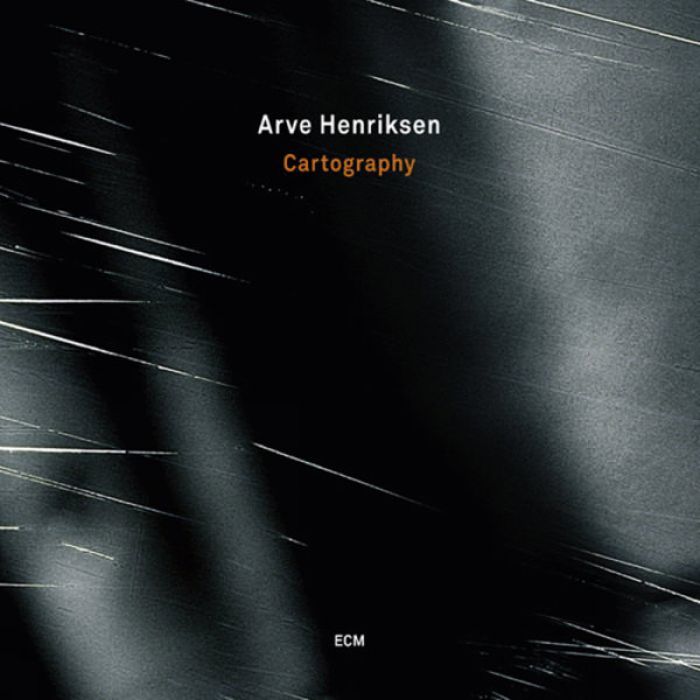Cartography by Arve Henriksen (Review)

It may be technically correct to label Arve Henriksen a “jazz trumpeter,” but it feels wrong. He does come from a jazz background, and he does play the trumpet. But he plays the trumpet in a manner that, to these ears at least, doesn’t conform to any usual notions of jazz.
Rather, Henriksen’s trumpet playing shows the heavy influence of the shakuhachi, a Japanese flute traditionally used by Buddhist monks as an aid for meditation and known for its breathy, otherworldly tones. Henriksen’s playing is often the model of restraint: he can kick up a whirling dervish of sound but his tone is often much more contemplative and stately, pulsing here and there amidst gasps and wisps of sound that can be surprisingly evocative given their slight structure.
Likewise, calling Cartography, Henriksen’s first album for the venerable ECM label, a “jazz album” may be technically correct, but it, too, feels wrong. As is the case with Henriksen’s playing, the term “jazz” just doesn’t do the music here justice. There may be moments that could fall under “traditional” ideas of jazz, but the album’s sonic palette is broader than that, venturing into the wide expanse of ambient and experimental music. The result is a record that is obtuse at times, loosely structured (if at all), and meandering, but is also very evocative and stirring.
Henriksen’s name is front and center on Cartography but this is very much a collaborative record. Those expecting some sort of virtuosic display on Henriksen’s part will be disappointing. While he does wail away on some tracks (e.g., “Loved One”), he’s more than content to fade into the background, appearing to provide additional color only when necessary, or to let his trumpet’s sounds be warped and transformed by the samplers and processors of co-producer Jan Bang into something only vaguely recognizable.
Indeed, while there are numerous collaborators on the album, including David Sylvian (Henriksen played on Sylvian’s Nine Horses project), no one contributor’s voice or contribution stands out or dominates — a good thing, in this case, as it helps the album achieve its unified, densely layered sound. Even Sylvian’s voice, which appears on the album’s two spoken word pieces (“Before and Afterlife” and “Thermal”), is looped, cut up, and processed, rendering it as just another instrument in the mix.
So, just how densely layered is this album? I feel like I could write a short essay on each song, as each one feels like a whole world in and of itself — a dark, smoky, mysterious, and somewhat eerie, but nevertheless captivating world.
The album opens with “Poverty and Its Opposite,” which finds Henriksen’s trumpet sighing and brooding over looping, shimmering electronics. As the piece progresses, skittering percussion (both real and artificial) filters in from the song’s edges, as does the low, weighty groans of a double bass. Henriksen’s trumpet eventually reappears high overhead, sounding lighter and more blissful, as if it’s attained some higher state of consciousness; the entire track carries with it a sense of muted, quiet religious awe and revelation.
On “Migration,” a standout track and one of the album’s most straightforward moments, Henriksen’s trumpet glides sensuously across a shimmering surface of synths, skeletal guitar figures, and ethnic percussion “seasoned” with hints of glitch and dub — an intoxicating and exotic mixture that evokes smokey Asian jazz bars at two in the morning. “Recording Angel” weaves together haunting vocal fragments and the ghosts of cinematic orchestral swells, and sounds like Portishead performing as they slowly sink into the Barents Sea; Henriksen’s trumpet might as well be the last tendrils of cigarette smoke escaping from Beth Gibbons’ lips before the waves close over her head.
The album ends with the pensive “Sorrow And Its Opposite,” which utilizes choral samples, gentle strings, and slabs of noise to achieve a reverent tone akin to that of the album’s opening. Again, I’m amazed at how Henriksen’s playing, though seemingly random, is never less than warm and generous as it melds with the song’s other sounds before ultimately giving way to a beautiful piano refrain that closes the album on a wistful, heartbreaking note.
When I normally see the words “experimental” and “jazz” used to describe an album, I turn tail and run: the term conjures up too many images of folks torturing their trumpets and saxes and producing cacophonies that serve little purpose other than, perhaps, to annoy the neighbors’ dogs. That couldn’t be further from the truth with Cartography, however.
Even when Henriksen is at his most “experimental” — and I even hesitate to use that word — the album remains intriguing and never gruelling. You probably won’t catch yourself whistling any of Henriksen’s phrases anytime soon, but don’t be surprised if you discover that Cartography’s mercurial, surprising, and captivating textures are stuck in your head nevertheless.